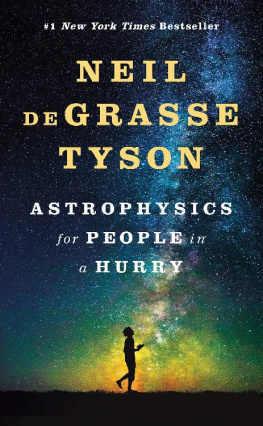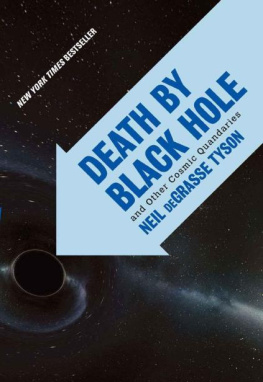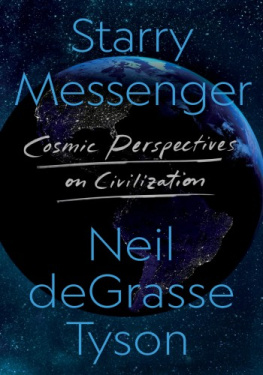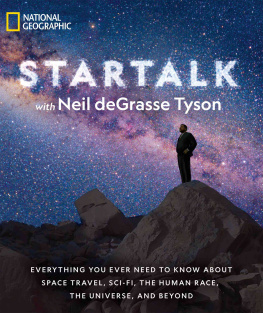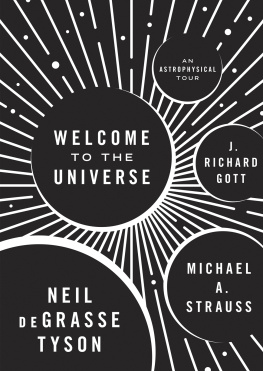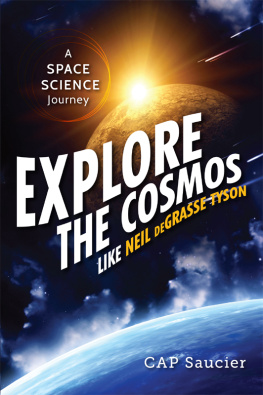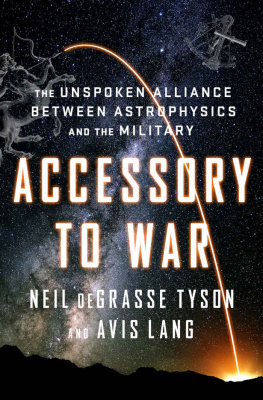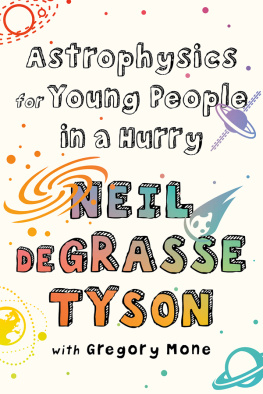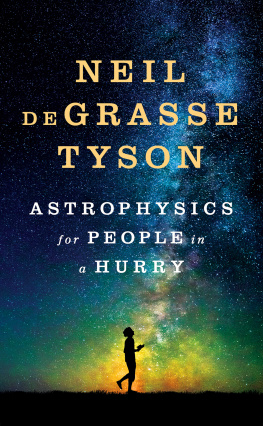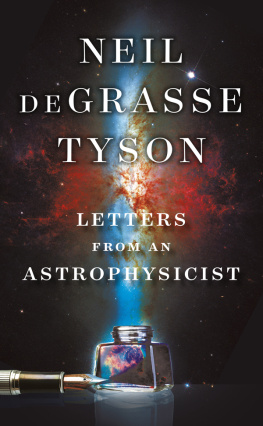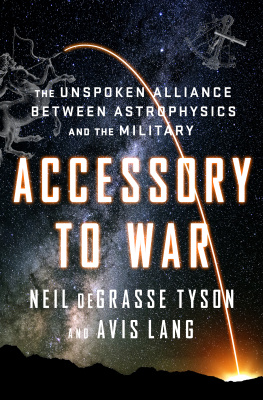Neil Degrasse Tyson - Astrophysics for People in a Hurry
Here you can read online Neil Degrasse Tyson - Astrophysics for People in a Hurry full text of the book (entire story) in english for free. Download pdf and epub, get meaning, cover and reviews about this ebook. year: 2017, publisher: W. W. Norton, genre: Religion. Description of the work, (preface) as well as reviews are available. Best literature library LitArk.com created for fans of good reading and offers a wide selection of genres:
Romance novel
Science fiction
Adventure
Detective
Science
History
Home and family
Prose
Art
Politics
Computer
Non-fiction
Religion
Business
Children
Humor
Choose a favorite category and find really read worthwhile books. Enjoy immersion in the world of imagination, feel the emotions of the characters or learn something new for yourself, make an fascinating discovery.
- Book:Astrophysics for People in a Hurry
- Author:
- Publisher:W. W. Norton
- Genre:
- Year:2017
- Rating:5 / 5
- Favourites:Add to favourites
- Your mark:
- 100
- 1
- 2
- 3
- 4
- 5
Astrophysics for People in a Hurry: summary, description and annotation
We offer to read an annotation, description, summary or preface (depends on what the author of the book "Astrophysics for People in a Hurry" wrote himself). If you haven't found the necessary information about the book — write in the comments, we will try to find it.
Astrophysics for People in a Hurry — read online for free the complete book (whole text) full work
Below is the text of the book, divided by pages. System saving the place of the last page read, allows you to conveniently read the book "Astrophysics for People in a Hurry" online for free, without having to search again every time where you left off. Put a bookmark, and you can go to the page where you finished reading at any time.
Font size:
Interval:
Bookmark:

Astrophysics for People in a Hurry

N EIL DE G RASSE T YSON

For all those who are too busy to read fat books Yet nonetheless seek a conduit to the cosmos

CONTENTS
In recent years, no more than a week goes by without news of a cosmic discovery worthy of banner headlines. While media gatekeepers may have developed an interest in the universe, this rise in coverage likely comes from a genuine increase in the publics appetite for science. Evidence for this abounds, from hit television shows inspired or informed by science, to the success of science fiction films starring marquee actors, and brought to the screen by celebrated producers and directors. And lately, theatrical release biopics featuring important scientists have become a genre unto itself. Theres also widespread interest around the world in science festivals, science fiction conventions, and science documentaries for television.
The highest grossing film of all time is by a famous director who set his story on a planet orbiting a distant star. And it features a famous actress who plays an astrobiologist. While most branches of science have ascended in this era, the field of astrophysics persistently rises to the top. I think I know why. At one time or another every one of us has looked up at the night sky and wondered: What does it all mean? How does it all work? And, what is my place in the universe?
If youre too busy to absorb the cosmos via classes, textbooks, or documentaries, and you nonetheless seek a brief but meaningful introduction to the field, I offer you Astrophysics for People in a Hurry . In this slim volume, you will earn a foundational fluency in all the major ideas and discoveries that drive our modern understanding of the universe. If Ive succeeded, youll be culturally conversant in my field of expertise, and you just may be hungry for more.
The universe is under no obligation to make sense to you.
NDT
Astrophysics for People in a Hurry

The world has persisted many a long year, having once been set going in the appropriate motions. From these everything else follows.
LUCRETIUS, C. 50 BC
I n the beginning, nearly fourteen billion years ago, all the space and all the matter and all the energy of the known universe was contained in a volume less than one-trillionth the size of the period that ends this sentence.
Conditions were so hot, the basic forces of nature that collectively describe the universe were unified. Though still unknown how it came into existence, this sub-pinpoint-size cosmos could only expand. Rapidly. In what today we call the big bang.
Einsteins general theory of relativity, put forth in 1916, gives us our modern understanding of gravity, in which the presence of matter and energy curves the fabric of space and time surrounding it. In the 1920s, quantum mechanics would be discovered, providing our modern account of all that is small: molecules, atoms, and subatomic particles. But these two understandings of nature are formally incompatible with one another, which set physicists off on a race to blend the theory of the small with the theory of the large into a single coherent theory of quantum gravity. Although we havent yet reached the finish line, we know exactly where the high hurdles are. One of them is during the Planck era of the early universe. Thats the interval of time from t = 0 up to t = 1043 seconds (one ten-million-trillion-trillion-trillionths of a second) after the beginning, and before the universe grew to 1035 meters (one hundred billion trillion-trillionths of a meter) across. The German physicist Max Planck, after whom these unimaginably small quantities are named, introduced the idea of quantized energy in 1900 and is generally credited as the father of quantum mechanics.
The clash between gravity and quantum mechanics poses no practical problem for the contemporary universe. Astrophysicists apply the tenets and tools of general relativity and quantum mechanics to very different classes of problems. But in the beginning, during the Planck era, the large was small, and we suspect there must have been a kind of shotgun wedding between the two. Alas, the vows exchanged during that ceremony continue to elude us, and so no (known) laws of physics describe with any confidence the behavior of the universe over that time.
We nonetheless expect that by the end of the Planck era, gravity wriggled loose from the other, still unified forces of nature, achieving an independent identity nicely described by our current theories. As the universe aged through 1035 seconds it continued to expand, diluting all concentrations of energy, and what remained of the unified forces split into the electroweak and the strong nuclear forces. Later still, the electroweak force split into the electromagnetic and the weak nuclear forces, laying bare the four distinct forces we have come to know and love: with the weak force controlling radioactive decay, the strong force binding the atomic nucleus, the electromagnetic force binding molecules, and gravity binding bulk matter.

A trillionth of a second has passed since the beginning.

All the while, the interplay of matter in the form of subatomic particles, and energy in the form of photons (massless vessels of light energy that are as much waves as they are particles) was incessant. The universe was hot enough for these photons to spontaneously convert their energy into matter-antimatter particle pairs, which immediately thereafter annihilate, returning their energy back to photons. Yes, antimatter is real. And we discovered it, not science fiction writers. These transmogrifications are entirely prescribed by Einsteins most famous equation: E = m c , which is a two-way recipe for how much matter your energy is worth, and how much energy your matter is worth. The c is the speed of light squareda huge number which, when multiplied by the mass, reminds us how much energy you actually get in this exercise.
Shortly before, during, and after the strong and electroweak forces parted company, the universe was a seething soup of quarks, leptons, and their antimatter siblings, along with bosons, the particles that enable their interactions. None of these particle families is thought to be divisible into anything smaller or more basic, though each comes in several varieties. The ordinary photon is a member of the boson family. The leptons most familiar to the non-physicist are the electron and perhaps the neutrino; and the most familiar quarks are... well, there are no familiar quarks. Each of their six subspecies has been assigned an abstract name that serves no real philological, philosophical, or pedagogical purpose, except to distinguish it from the others: up and down , strange and charmed , and top and bottom .
Next pageFont size:
Interval:
Bookmark:
Similar books «Astrophysics for People in a Hurry»
Look at similar books to Astrophysics for People in a Hurry. We have selected literature similar in name and meaning in the hope of providing readers with more options to find new, interesting, not yet read works.
Discussion, reviews of the book Astrophysics for People in a Hurry and just readers' own opinions. Leave your comments, write what you think about the work, its meaning or the main characters. Specify what exactly you liked and what you didn't like, and why you think so.

